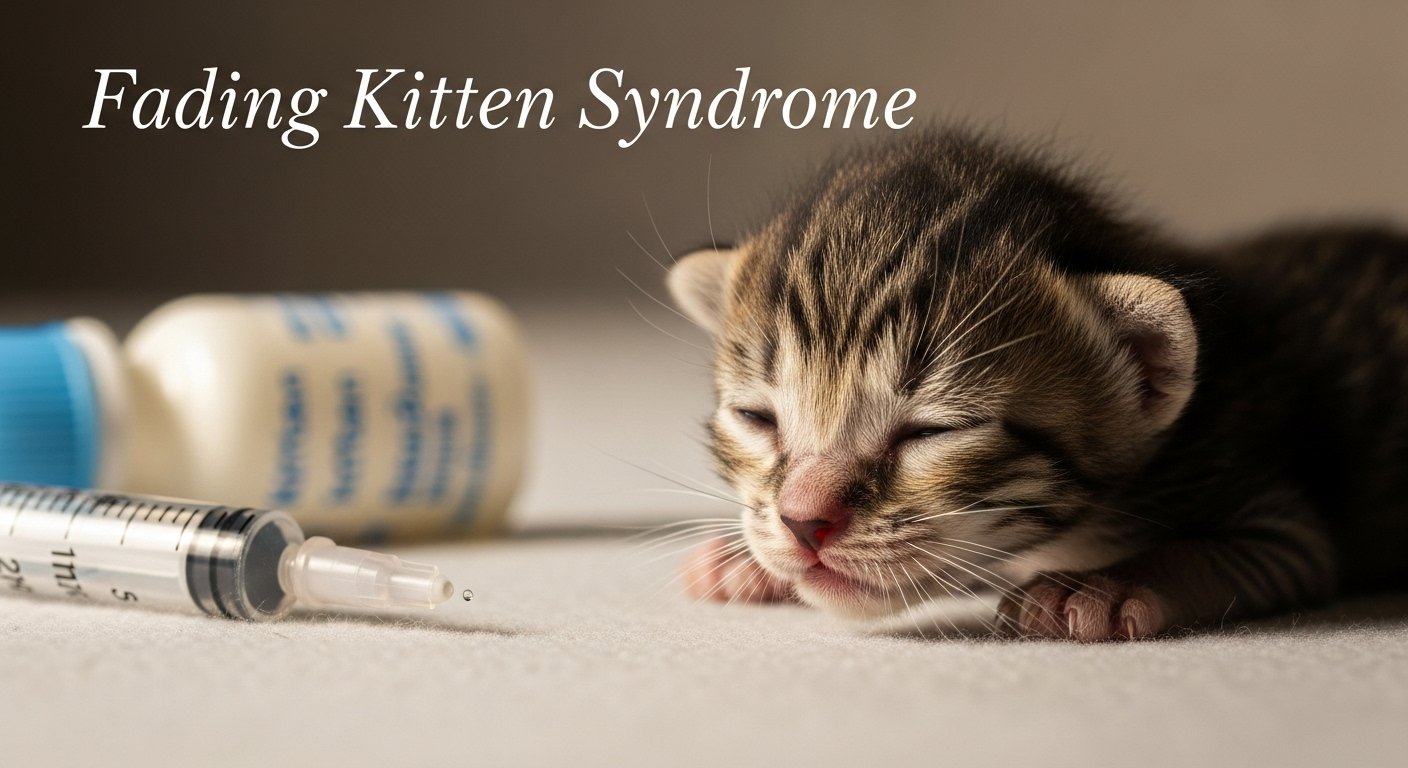Introduction
If you love kittens or have cared for newborn ones, you may have heard of fading kitten syndrome. It’s a scary term, but it’s very important to understand. Fading kitten syndrome is not a disease by itself. Instead, it’s a group of problems that cause a young kitten, usually under eight weeks old, to become weak and possibly die. These little ones may stop eating, lose energy, or feel cold. Many times, it happens suddenly and without warning. This condition is heartbreaking for caretakers, breeders, or anyone who rescues cats. But knowing the signs and what steps to take can actually save lives. In this guide, we’ll walk through everything you need to know about fading kitten syndrome, including symptoms, causes, prevention, and real-life tips to help kittens thrive.
What Exactly Is Fading Kitten Syndrome?
Fading kitten syndrome is a term used by vets and rescuers when a kitten starts declining fast. It often happens to kittens under two months old. These kittens may have been born weak or seemed fine but suddenly lost their strength. They might refuse to nurse, sleep too much, or become cold to the touch. Sometimes, there’s no clear reason. But what’s happening inside their tiny bodies is serious. It means something is wrong—either a disease, infection, birth defect, poor nutrition, or trouble staying warm. Fading kitten syndrome is not a disease you can test for. Instead, it’s a signal that the kitten is in danger and needs help right away.
Common Causes of Fading Kitten Syndrome
There are many reasons why a kitten might develop fading kitten syndrome. One of the most common causes is hypothermia, meaning the kitten’s body gets too cold and can’t warm up. Tiny kittens can’t control their body temperature, so if they are not kept warm, they can go downhill fast. Another cause is dehydration if they don’t get enough milk or fluids. Infections, birth defects, parasites, and poor nutrition can all play a role. Sometimes, the mother cat can’t care for her kittens properly or produces low milk. Other times, kittens can’t latch or feed normally. Being the “runt” of the litter—a kitten born smaller and weaker—can also increase the chances of fading.
Signs and Symptoms to Watch For
Recognizing early symptoms of fading kitten syndrome can help you act quickly. Warning signs include lack of appetite, weak suckling, weight loss, or very slow weight gain. The kitten might feel cold or limp when held. Other signs include loud crying, weakness, pale gums, breathing problems, and sleeping too much. A healthy kitten should be round, warm, and active. If you notice a kitten that separates from the group, refuses food, or seems less responsive, take action right away. Many cases get worse fast, so even small changes should be taken seriously. When in doubt, always reach out to a vet.
Why Warmth Is Essential for Newborn Kittens
Keeping a kitten warm is one of the most critical steps in preventing fading kitten syndrome. Newborn kittens can become dangerously cold in just a few minutes. Their bodies can’t regulate heat like human babies or adult animals. A chilled kitten won’t be able to digest food either, which makes things even worse. If a kitten’s body temperature drops, feeding it before warming it up can do more harm than good. That’s why you must always warm a cold kitten to about 99°F before trying to feed it. Use a heating pad set on low, warm water bottles wrapped in towels, or even your own body heat if there’s nothing else.
Feeding and Hydration Support for Fading Kittens
Feeding is tricky but key for kittens with fading kitten syndrome. Kittens should eat every 2–4 hours, depending on their age. If they can’t nurse from their mother, use a kitten milk replacer—not cow’s milk. Only feed them after they are warm or you risk upsetting their belly. Hydration is just as important. A weak kitten can become dehydrated fast, especially if they have diarrhea or can’t nurse well. You may need to use a syringe or dropper to give kitten formula slowly. Be gentle, go slowly, and watch for signs they’re swallowing. If you’re unsure, contact a vet to learn how to feed a weak kitten safely.
When to Call the Vet Right Away
If a kitten shows signs of fading kitten syndrome, don’t wait too long to seek help. Vets can provide fluids, medications, warming support, and feeding guidance. Call your vet if the kitten is unresponsive, strongly crying, cold to the touch, refusing to eat, has trouble breathing, or is rapidly losing weight. Acting fast is the best way to give the kitten a fighting chance. Keep track of the kitten’s weight, food intake, and behaviors. All this helps the vet see how urgent things are. No matter your experience, a professional’s advice can make the difference between life and loss in fragile cases.
Importance of Monitoring Weight Daily
One easy way to protect kittens from fading kitten syndrome is by weighing them every day. A small digital scale, like the kind used for food, can help track even tiny weight changes. Healthy kittens should gain about 10–15 grams daily. If a kitten doesn’t gain weight for two days or starts losing weight, that’s a big red flag. Weigh them at the same time every day, like in the morning, and write down the results. You’ll be able to spot problems early, long before it’s too late. Many rescuers say daily weighing saved kittens they didn’t even know were struggling yet.
Helping Orphaned or Rejected Kittens

Some kittens develop fading kitten syndrome because they have no mother to feed or care for them. This is common in orphaned or rejected babies. These kittens need human help to survive. You’ll need to keep them very warm, feed them kitten milk formula around the clock, and help them go to the bathroom by gently rubbing their lower belly with a warm, damp cloth. Kittens younger than three weeks can’t go potty on their own. An orphaned kitten is more fragile, but with proper care, they can grow into strong, healthy cats. It takes work, but it’s also incredibly rewarding to help a tiny life thrive.
What to Put in a Newborn Kitten Care Kit
To lower the chances of fading kitten syndrome, every kitten caregiver should have a small care kit ready. Start with a digital baby or kitchen scale, kitten milk replacer, soft bottles or feeding syringes, and a small animal heating pad or warm blanket. Add clean towels, a thermometer, baby wipes, and gloves. You’ll also want a carrier or small box with high sides to keep the kittens safe. White rice socks (cloth bags with rice that you microwave) work well for soft warmth. Having everything ready means you can act fast when a kitten shows signs of stress or weakness.
The Role of the Mother Cat in Prevention
When a mother cat is healthy and experienced, she helps protect her kittens against fading kitten syndrome. She keeps them clean, warm, and fed. But even with good mother cats, things can go wrong. A stressed mother may not care for her young well. First-time moms may accidentally ignore or step on their babies. If she gets sick or stops producing milk, her kittens quickly start to fade. That’s why it’s important to watch the mother and kittens closely in those first few weeks. Even if she’s doing well, human eyes can catch small changes early and offer help if needed.
Building a Healthy, Low-Stress Environment
A calm space helps prevent fading kitten syndrome. Loud noises, cold air, or constant handling can stress kittens and their mom. Stress can reduce her milk supply or upset her routine. If kittens are bottle-fed, stress can make them eat less or sleep more than they should. Set up a quiet, clean, warm space just for your kittens. Keep lighting soft, avoid sudden loud sounds, and wash your hands before touching them. Limit visitors during the first few weeks. This quiet, cozy setup helps kittens grow in peace and gives their fragile bodies the best chance to stay strong.
Can Kittens Recover From Fading Kitten Syndrome?
Yes, many kittens have recovered from fading kitten syndrome, especially when caught and treated early. The sooner you notice and act, the better the outcome. Once the kitten is warm, fed, and hydrated, you may see signs of energy returning in just hours. With vet care, fluids, careful feeding, and love, some kittens bounce back beautifully. Others may stay fragile for weeks but slowly gain strength. The key is never giving up. These tiny lives are resilient. Each kitten saved is a reminder of the power of care, patience, and hope.
Supporting Others Who Face Fading Kitten Syndrome
If you’ve cared for a kitten with fading kitten syndrome, you know how emotional it can be. Whether you save the kitten or lose them, your experience matters. Share your story with others. New foster parents or first-time owners can learn from what you’ve seen. Let people know they’re not alone. Offer comfort, advice, or even supplies you no longer need. This simple support system helps more kittens survive. Together, we can make a difference—one tiny life at a time.
FAQs
1. What is fading kitten syndrome?
Fading kitten syndrome is a group of problems that causes newborn kittens to become weak and possibly die if not treated quickly.
2. What causes fading kitten syndrome?
Common causes include cold temperatures, dehydration, infections, birth defects, parasites, or poor feeding support.
3. Can you save a kitten with fading kitten syndrome?
Yes, if caught early and treated—many kittens recover with warmth, feeding, and veterinary care.
4. What are the first signs to watch for?
Look for cold body temperature, refusing to nurse, weight loss, weak crying, or acting very sleepy and floppy.
5. How can I prevent fading kitten syndrome?
Keep kittens warm, feed them on time with the right formula, and weigh them daily to catch problems early.
6. Should I take a fading kitten to the vet?
Yes! A vet can give fluids, medicine, and care that are often critical to saving the kitten’s life.
Conclusion
Fading kitten syndrome is scary—but it’s not hopeless. The smallest kitten can often survive with the right care, quick action, and a little help from others. Whether you’re a breeder, foster parent, or animal lover, learning these signs and sharing this knowledge can save lives. Each kitten matters. By staying informed and prepared, you’re giving these tiny babies a chance to grow up strong and loved. If you’re reading this because you’re caring for a kitten right now—don’t give up. Your kindness, time, and love truly make a difference. Share this guide with other caregivers so more kittens can have a bright, healthy future.



